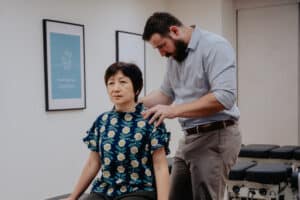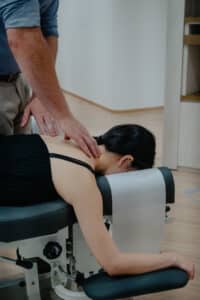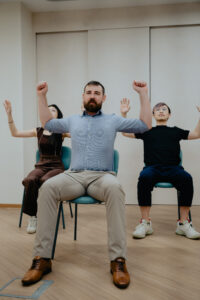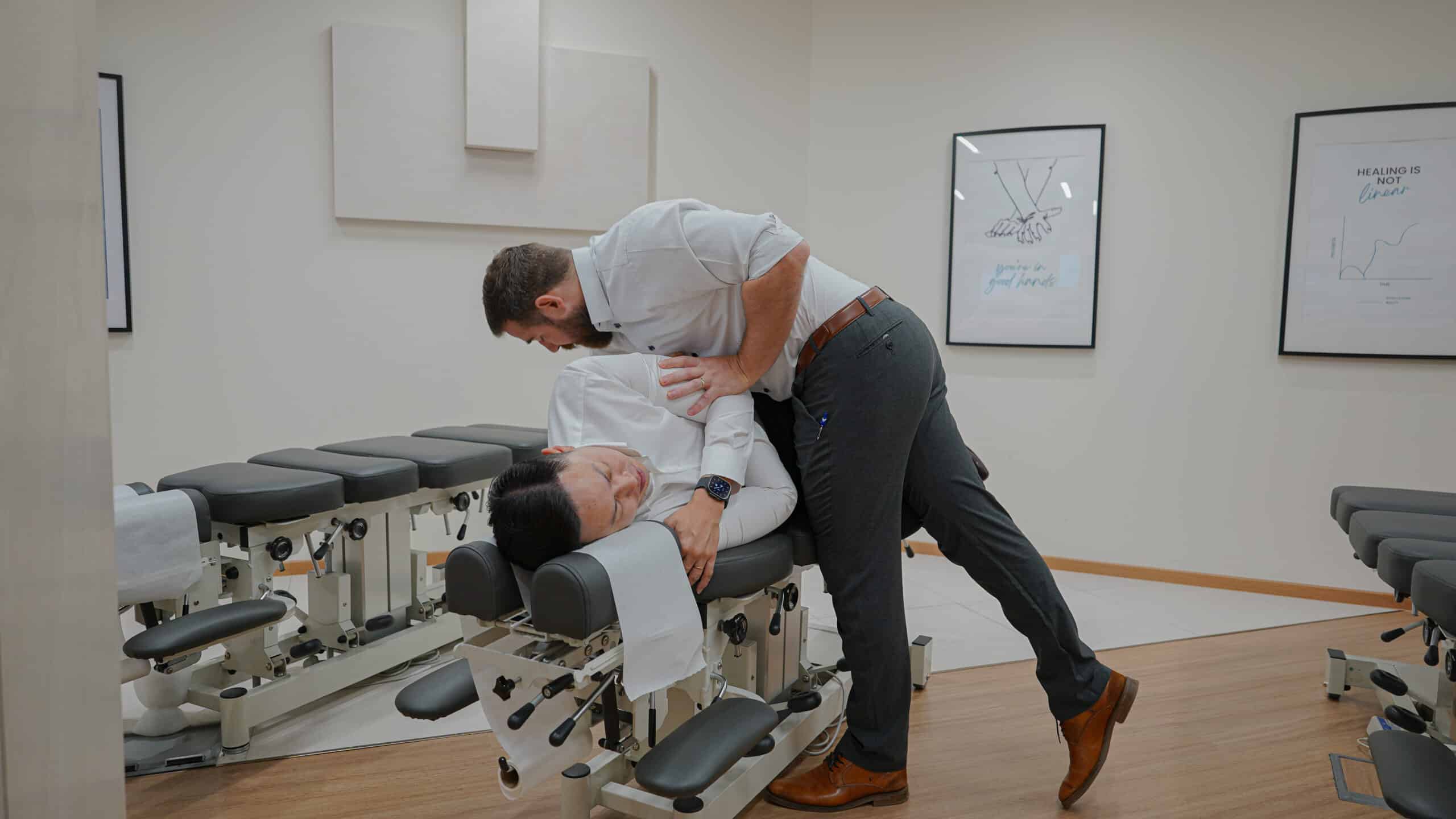Corrective therapy is a structured chiropractic approach that focuses on improving posture, restoring spinal alignment, and addressing the root causes of musculoskeletal imbalances. Unlike short-term pain relief methods, corrective therapy aims to bring sustainable change, helping individuals move more freely and comfortably.
In Singapore, where desk-bound work and digital lifestyles are common, posture issues are increasingly prevalent. Corrective therapy provides a natural and non-invasive way to address these concerns.
What is corrective therapy and why is it important?
Corrective therapy is a specialised form of chiropractic care designed to correct postural misalignments and spinal dysfunctions. The approach involves detailed assessments and tailored adjustments that target the underlying causes of discomfort rather than simply treating symptoms.

Good posture is essential for overall health. When the spine is properly aligned, your muscles, joints, and nerves function more effectively, supporting better movement and resilience. Without timely intervention, misalignments may lead to persistent pain, reduced mobility, and longer-term complications that can significantly affect quality of life.
At Chiropractic Singapore, corrective therapy is often recommended for conditions such as:
- Sciatica – caused by pressure on the sciatic nerve leading to pain down the leg
- Scoliosis – abnormal curvature of the spine affecting posture and function
- Frozen Shoulder – stiffness and pain that limit shoulder movement
- Neck Pain – often linked to poor posture, desk work, or spinal misalignments
- Lower Back Pain – one of the most common results of spinal stress or imbalance
- Headaches & Migraines – which may be aggravated by tension and poor spinal alignment
By addressing the underlying spinal issues contributing to these conditions, corrective therapy helps restore alignment, ease discomfort, and improve overall wellbeing.
How does corrective therapy work in Singapore?
Corrective therapy in Singapore typically follows a structured process that may include:
- A thorough consultation and posture assessmentAt Chiropractic Singapore, we carry out six different diagnostic tests to identify the root cause of your condition and tailor your care:
- One-to-one consultation with your chiropractor
- Posture photographs for visual analysis
- Weight distribution measurements to check spinal balance
- Grip strength tests to assess nerve function and muscle strength
- Range of motion checks to identify movement restrictions
- Surface EMG (SEMG) scans to detect muscular imbalances
- Spinal imaging or scans where required. At Chiropractic Singapore, if clinically indicated, we work with our trusted X-ray partners and use the results to gain a more detailed understanding of your spinal health, alignment, and any underlying structural concerns.
- Bone adjustment chiropractic techniques to restore alignment** At Chiropractic Singapore, our chiropractors use safe and precise spinal adjustments, tailored to your condition, to reduce nerve interference, restore mobility, and improve overall function.
- Guidance on posture correction exercises and lifestyle changes At Chiropractic Singapore, we give personalised exercise and stretch plans designed to sustain the effects of your adjustments. Alongside this, we provide practical lifestyle and ergonomic advice to help reinforce spinal alignment, reduce daily strain, and minimise the likelihood of recurring issues.
- Regular follow-up assessments to track improvements and adjust the care plan if needed At Chiropractic Singapore, we monitor your progress with repeat posture photographs, SEMG scans, and functional checks. This ensures your care plan evolves with your improvements, keeping your recovery on track.
This comprehensive approach ensures that therapy is customised to each individual’s needs, improving posture and function over time.
What bone adjustment chiropractic techniques are used in corrective therapy?
Bone adjustment chiropractic forms the foundation of corrective therapy. Using precise manual or instrument-assisted adjustments, chiropractors gently realign the spine and joints. These techniques reduce nerve interference, restore range of motion, and help the body function more effectively.
When combined with exercises and lifestyle guidance, bone adjustments support long-term postural correction.
Is corrective therapy in Singapore safe?
Corrective therapy is considered safe when performed by trained professionals. Chiropractors use evidence-based methods and adapt care to suit each patient’s condition. Safety and comfort are prioritised at every stage of treatment, with clear communication throughout the process.
Can corrective therapy improve posture long term?
Yes, corrective therapy is intended to deliver lasting results. By addressing structural issues and retraining supporting muscles, the therapy encourages the body to maintain healthier alignment naturally. Many individuals notice sustained improvements in posture, reduced tension, and enhanced mobility when following a consistent care plan.
Who may benefit from corrective therapy?
Corrective therapy is suitable for a wide range of people, especially those looking for long-term solutions to posture and spinal health concerns. It can be particularly beneficial for:
- Individuals with recurring back, neck, or shoulder pain – Corrective therapy addresses the underlying misalignments that often cause discomfort.
- Office workers and students who spend long hours seated** – Extended desk work and device use can lead to slouched posture, tight muscles, and spinal strain.
- Those noticing uneven shoulders or slouched posture – Corrective therapy helps retrain the body to maintain proper alignment.
- People struggling with stiffness or reduced flexibility – Gentle adjustments and posture exercises can restore better mobility and ease of movement.
In Singapore, where sedentary work habits, digital lifestyles, and prolonged sitting are common, corrective therapy is especially relevant. By targeting the root causes of misalignment, it helps individuals improve posture, enhance mobility, and feel more comfortable in daily life.
What results can be expected from corrective therapy?
Corrective therapy is designed to create long-lasting improvements rather than short-term relief. With consistent sessions and supportive lifestyle habits, many individuals experience noticeable changes such as:
individuals experience noticeable changes such as:
- Reduced pain and discomfort – Relief from recurring back, neck, or shoulder tension caused by poor posture or misalignment.
- Improved spinal alignment and posture – A straighter, more balanced posture that makes sitting, standing, and moving easier.
- Greater mobility and flexibility – Stiffness decreases as joints and muscles regain their natural range of motion.
- More confidence in daily activities – Everyday tasks, from working at a desk to exercising, feel more comfortable and natural.
- Enhanced overall well-being – Better posture and alignment often contribute to improved energy, focus, and body awareness.
Results can vary depending on the individual’s condition, consistency, and lifestyle. However, the key focus of corrective therapy is on sustainable change—helping the body stay aligned and balanced well into the future, rather than offering quick but temporary fixes.
Are posture correctors as effective as corrective therapy?
Posture correctors may offer temporary support, but they do not resolve the underlying causes of poor posture. Over-reliance on external devices can even weaken muscles if used excessively.

Corrective therapy, on the other hand, retrains the spine and muscles to maintain proper alignment naturally. This makes it a more comprehensive and sustainable option compared to posture correctors alone.
What happens during Your first corrective therapy session?
A first session in corrective therapy generally includes:
- A consultation to discuss symptoms and lifestyle factors
- A posture and spinal assessment, with scans if required
- A personalised corrective care plan with clear goals
- An explanation of corrective therapy steps, duration, and expected outcomes
This structured process ensures transparency and sets the foundation for effective results.
How long does corrective therapy usually take?
The length of a corrective therapy programme depends on the severity of misalignments and individual goals. In most cases, programmes span several months, starting with more frequent sessions and tapering down to maintenance visits.
Consistency is key—lasting results often require commitment to the full care plan.
What lifestyle habits enhance corrective therapy results?
Daily habits play a crucial role in maximising the benefits of corrective therapy. Helpful practices include:
- Taking breaks from sitting every 30–60 minutes
- Adjusting workstations ergonomically
- Staying active with stretching and strengthening routines
- Using supportive furniture such as ergonomic chairs
- Maintaining a healthy lifestyle through proper hydration and nutrition
When combined with corrective therapy, these habits create a supportive environment for lasting posture improvement.
What posture correction exercises can support therapy?
Posture correction exercises are an excellent way to enhance the results of corrective therapy. They strengthen weak muscles, stretch tight areas, and train the body to adopt healthier movement patterns throughout the day. When practised regularly, these exercises make it easier to maintain good posture and reduce the likelihood of recurring discomfort.
patterns throughout the day. When practised regularly, these exercises make it easier to maintain good posture and reduce the likelihood of recurring discomfort.
Some effective posture correction exercises include:
- Chin tucks – Gently pull the chin towards the neck to counter forward head posture and strengthen deep neck flexors.
- Shoulder blade squeezes – Draw the shoulder blades back and down to reduce slouching and activate postural support muscles.
- Wall angels – Performed with the back against a wall, this exercise opens the chest, improves shoulder mobility, and encourages upright alignment.
- Core strengthening – Engaging the abdominal and back muscles provides stability for the spine, making it easier to hold good posture.
Incorporating these posture correction exercises alongside corrective therapy creates a powerful combination. It not only reinforces spinal adjustments but also helps prevent relapse by teaching the body to sustain proper alignment in everyday activities.
*Learn more stretches and exercises here.*
Why choose Chiropractic Singapore for corrective therapy?
Chiropractic Singapore provides professional care tailored to long-term posture and spinal health. Our corrective therapy programmes combine bone adjustment chiropractic techniques, guided posture correction exercises, and lifestyle advice to help individuals achieve sustainable results.
By focusing on the root causes of posture issues, we support our patients in improving mobility, reducing discomfort, and building healthier alignment for the future.
👉 Ready to improve your posture and spinal health? Book your corrective therapy consultation with Chiropractic Singapore today.
FAQ’s about Corrective Therapy
1. Can corrective therapy help with sports injuries?
Yes. Corrective therapy can support recovery from sports-related strains by improving alignment, reducing tension, and restoring better movement patterns.
2. Does corrective therapy only work for adults?
No. While many adults seek corrective therapy, younger individuals with posture issues or growing pains may also benefit under professional guidance.
3. Is corrective therapy the same as physiotherapy?
Not exactly. Corrective therapy focuses on spinal alignment and posture through chiropractic techniques, while physiotherapy often addresses muscle rehabilitation and physical function after injury.
4. Do I need scans before starting corrective therapy?
Scans or X-rays are not always required but may be recommended if a chiropractor needs a clearer picture of spinal health before creating a care plan.
5. Can corrective therapy help with headaches or migraines?
For some individuals, yes. Poor posture and spinal misalignments can contribute to tension headaches, and corrective therapy may help reduce these triggers.









